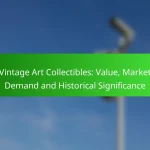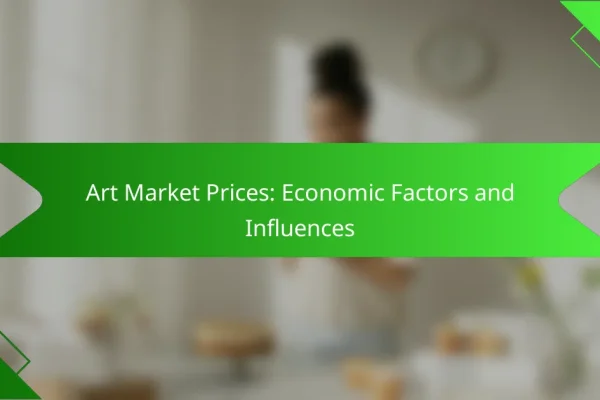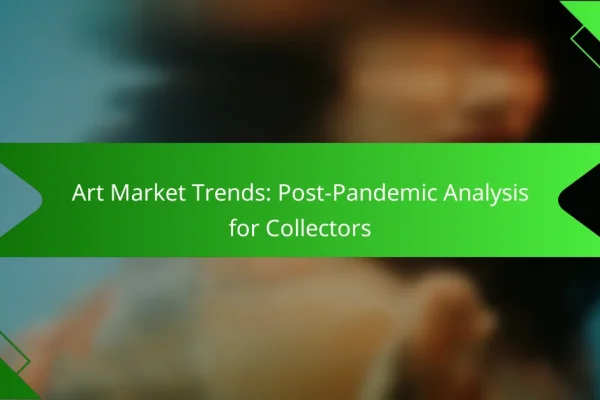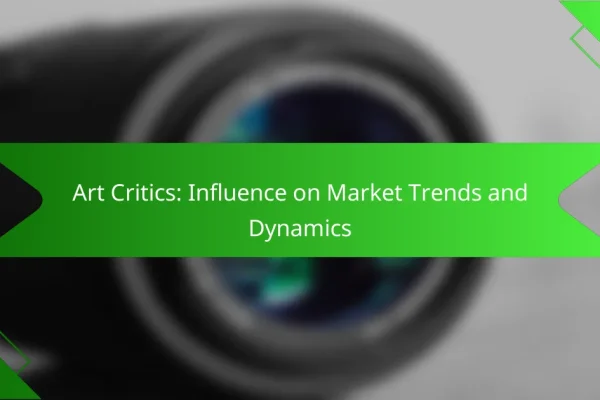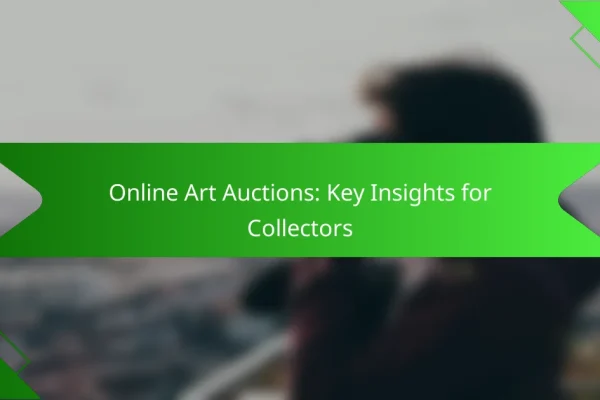What are the current art market trends in the United States?
The current art market trends in the United States reflect a significant shift towards digital platforms, increased interest in non-fungible tokens (NFTs), and the emergence of new artists. These trends indicate a dynamic landscape where traditional methods of buying and selling art are evolving rapidly.
Increased online art sales
Online art sales have surged in recent years, driven by the convenience of digital platforms and the impact of the COVID-19 pandemic. Many galleries and auction houses have adapted by enhancing their online presence, offering virtual exhibitions and online bidding options.
In 2022, online art sales accounted for a substantial portion of total art sales, with estimates suggesting it could be around 20-30%. This trend is likely to continue as collectors become more comfortable purchasing art online.
Growing interest in NFTs
The interest in NFTs has transformed the art market, allowing artists to sell digital works in new ways. NFTs provide proof of ownership and authenticity, making them appealing to both artists and collectors.
While the NFT market can be volatile, it has attracted significant investment, with some digital artworks selling for millions of dollars. Artists are increasingly exploring this medium, creating unique pieces that cater to a tech-savvy audience.
Emergence of new artists
The art market is witnessing the rise of new artists, often supported by social media and online platforms. Emerging artists are finding ways to connect with audiences directly, bypassing traditional gatekeepers like galleries.
Many of these artists focus on contemporary themes and diverse perspectives, appealing to a broader demographic. Collectors are encouraged to explore these new voices, as they often offer fresh ideas and innovative approaches to art-making.
How are economic factors influencing the art market?
Economic factors significantly impact the art market by affecting both demand and pricing. Changes in inflation rates, consumer confidence, and overall economic health can alter how collectors and investors approach art purchases.
Impact of inflation on art prices
Inflation tends to increase the cost of materials and production, which can drive up art prices. As the purchasing power of currency decreases, collectors may turn to art as a hedge against inflation, further elevating demand.
For example, during periods of high inflation, art prices may rise by double-digit percentages, reflecting both increased costs and heightened interest from investors seeking stable assets. Collectors should monitor inflation trends to anticipate potential shifts in the market.
Effects of economic downturns on luxury spending
Economic downturns typically lead to reduced luxury spending, which can negatively affect the art market. During recessions, collectors may prioritize essential expenditures over art acquisitions, resulting in lower sales and stagnant prices.
However, some segments of the art market, particularly high-value pieces, may remain resilient as affluent buyers continue to invest in art as a status symbol. Understanding the economic climate can help collectors make informed decisions about when to buy or sell art.
What are the key demographics driving art purchases?
The key demographics driving art purchases primarily include Millennials and Gen Z, who are reshaping the art market with their unique preferences and values. These groups are characterized by their digital engagement and a strong inclination towards authenticity and social impact in their buying decisions.
Millennials as primary buyers
Millennials are currently the largest segment of art buyers, often seeking pieces that resonate with their personal experiences and values. They typically invest in contemporary art, favoring works that reflect social issues or cultural narratives.
In terms of spending, Millennials may allocate anywhere from a few hundred to several thousand dollars on art, depending on their financial situation and the significance of the piece. They are also more likely to purchase art through online platforms, which provide accessibility and a wider range of options.
Role of Gen Z in art consumption
Gen Z is emerging as a significant force in the art market, driven by their digital nativity and emphasis on social justice. This generation tends to support artists who align with their values, often prioritizing diversity and sustainability in their art choices.
While still in the early stages of their purchasing power, Gen Z is likely to spend modestly on art, often focusing on affordable pieces or digital art forms like NFTs. Their engagement with social media platforms also influences their art consumption, as they seek out trends and community-driven projects that reflect their identities.
How is technology shaping the art market?
Technology is transforming the art market by enhancing accessibility, enabling new sales channels, and creating innovative ways to experience art. Digital platforms and tools are reshaping how artists, galleries, and collectors interact and transact.
Virtual galleries and exhibitions
Virtual galleries and exhibitions allow artists and galleries to showcase their work online, reaching a global audience without geographical limitations. These platforms often provide immersive experiences, enabling viewers to explore artworks in a 3D environment.
Many virtual exhibitions are designed to mimic physical spaces, offering features like guided tours and interactive elements. Artists can also benefit from reduced overhead costs associated with physical venues, making it easier to host events and display their work.
Use of augmented reality in art sales
Augmented reality (AR) is increasingly used in art sales to enhance the buying experience. AR applications allow potential buyers to visualize how a piece of art would look in their own space, bridging the gap between the digital and physical worlds.
For example, apps can overlay digital images of artworks onto real-world environments through smartphones or tablets. This technology not only aids in decision-making but also engages customers in a more interactive way, potentially increasing sales conversion rates.
What are the most significant art fairs and auctions in 2023?
In 2023, major art fairs and auctions such as Art Basel Miami Beach and Christie’s 21st Century Evening Sale have played pivotal roles in shaping the art market. These events showcase high-value artworks and attract collectors, investors, and art enthusiasts from around the globe.
Art Basel Miami Beach
Art Basel Miami Beach is one of the premier art fairs, renowned for its vibrant atmosphere and high-profile galleries. Held annually in December, it features contemporary artworks from leading international galleries, making it a key event for collectors looking to acquire significant pieces.
Visitors can expect to see a diverse range of artworks, including paintings, sculptures, and installations. The fair also hosts numerous events, including panel discussions and artist talks, providing insights into current trends and market dynamics.
Christie’s 21st Century Evening Sale
Christie’s 21st Century Evening Sale is a highlight of the auction calendar, focusing on contemporary and modern art. This auction typically takes place in May and November, showcasing works by influential artists from the 21st century, which often command high prices.
Buyers should be prepared for competitive bidding, as pieces from renowned artists can sell for millions of dollars. It’s advisable to research past auction results and set a budget before participating, as prices can vary significantly based on the artist’s market demand and the artwork’s provenance.
What criteria should collectors consider when investing in art?
Collectors should prioritize provenance, authenticity, and market demand when investing in art. Understanding these criteria helps ensure that investments are sound and have the potential for appreciation over time.
Provenance and authenticity
Provenance refers to the history of ownership of a piece of art, which can significantly affect its value. Collectors should verify the chain of ownership and any documentation that confirms the authenticity of the artwork. This includes certificates of authenticity, gallery receipts, and auction house records.
Authenticity is crucial in the art market, as forgeries can severely impact a collector’s investment. Engaging reputable appraisers or experts can help in assessing the legitimacy of a piece. Always request detailed documentation that supports the artwork’s provenance and authenticity.
Market demand and trends
Understanding market demand and trends is essential for making informed art investments. Collectors should research current trends in the art market, including popular styles, artists, and mediums. This can involve following art fairs, auctions, and gallery exhibitions to gauge what is gaining traction.
Additionally, collectors should consider the potential for future appreciation. Investing in emerging artists or underrepresented styles can yield significant returns, but it also carries risks. Keeping an eye on auction results and sales data can provide insights into which segments of the market are thriving.
What are the emerging trends in the global art market?
Emerging trends in the global art market include a shift towards digital platforms, increased focus on sustainability, and the growing influence of younger collectors. These trends reflect changing consumer preferences and a response to global challenges.
Rise of sustainable art practices
The rise of sustainable art practices is characterized by artists and galleries prioritizing eco-friendly materials and methods. This trend addresses environmental concerns and resonates with collectors who value sustainability.
Artists are increasingly using recycled materials, non-toxic paints, and sustainable sourcing for their artworks. For example, some creators are turning to upcycled objects or natural pigments, which not only reduce waste but also tell a compelling story about the artwork’s origin.
Collectors interested in sustainable art should consider the environmental impact of their purchases. Look for certifications or labels that indicate eco-friendly practices, and engage with artists who openly discuss their sustainability efforts. This not only supports responsible art-making but also enhances the value of the collection over time.





